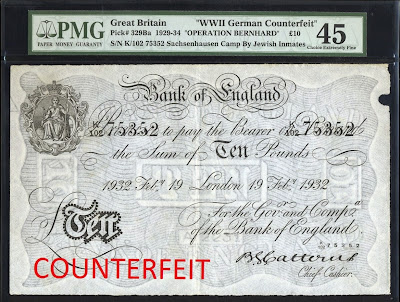In the middle of World War II, Tangier was the perfect spot for spies. Its political neutrality and commercial liberty during the 40s, granted the city the reputation of an espionage and smuggling center in North Africa.
All these activities taking part in Morocco’s northern town, allowed the British to foil one of the most dangerous operations conducted by Nazi Germany. Dubbed Operation Bernhard, the plot was initiated by the Germans to bring about a collapse of the British economy during the war.
Operation Bernhard
Since 1940, the German duplicated the rag paper used by the British to produce almost identical notes. But by 1943, the Bank of England discovered that thanks to one of Tangier’s banks.

«The British (…) unraveled Germany’s Operation Bernhard in Tangiers, putting an end to the mass forgery of Sterling currency», wrote Alfred A. Cohen in his book «Galula : The Life and Writings of the French Officer who Defined the Art of Counterinsurgency» (ABC-CLIO, 2012).
Discovered in Tangier
To put it in other words, in 1943, a British bank in the Moroccan city pinpointed for the first time samples of the high-quality forged British currency, produced by the Nazis in their Operation Bernhard.
However, before the British bank stumbles upon the fake notes, the Bank of England knew about Germany’s plot. «As early as 1939, the leaders of the Bank of England, through a spy, were aware of the German plan to produce counterfeit banknotes», reports Knowledgenuts.
«It wasn’t until 1943, in a British bank in Tangiers, that they finally got their hands on some of it, declaring it to be 'the most dangerous ever seen'», added the same source. But, unfortunately, the Germans were able to create the right material to «duplicate the watermarks» and managed to «crack the secret to the serial numbers on the banknotes», says the same platform.
It was not revealed how the clerks at the British bank in Tangiers identified the counterfeit, but the Jewish Virtual Library recalls in an article that they «were recorded, like all notes, in handwritten ledgers still in the Bank’s archives (every banknote issued by the Bank of England as late as the 1940s was recorded in large leather-bound ledgers, as the notes were a liability of the bank)».

«It was noted that one of the notes had already been recorded as having been paid off», wrote the library, adding that «the counterfeiting team also turned its attention to US currency, producing samples of one side of $100 bills on February 22, 1945 with full production scheduled to start the next day, but the Reich Security Main Office ordered the work halted and the press dismantled».
But, when the British revealed Germany’s operation the duplicated banknotes in Morocco, the money went into general circulation. The bank of England decided, at the time, to stop releasing new notes and issued a new design after the war.





 chargement...
chargement...













